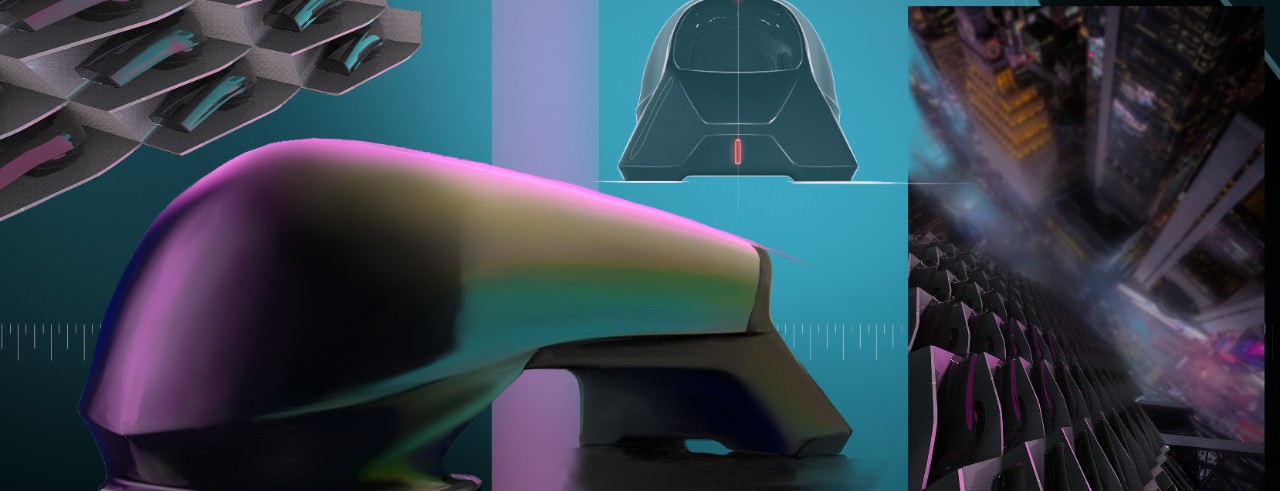
UC industrial design students use VR technology to model the future of transportation
UC's Future Mobility Design Lab aided by corporate partner
Two decades ago, an all-electric vehicle was a faraway – and likely impossible thought – for the average person. Now, electric cars, trucks and buses are commonplace.

The Hex Pod designed by third-year industrial design student Jimmy Tran. Photo/provided.
Fast forward to 2040, and the next evolution in transportation, say experts and students in UC’s industrial design program, will be the self-driving vehicle; and at UC, they are using VR technology to perfect the design process.
“It (VR design) was a little bit of a learning curve at the beginning, but it was amazing once you understand it,” says third year industrial design student Jimmy Tran whose design for the Canoo Hex Pod was featured in a WVXU “Focus on Technology” segment.
“When I was a student, it really took me about three years to be at a level where I was competent in transportation design, but these students pick it up in a month,” using VR software, says Alejandro Lozano Robledo who oversees UC’s Future Mobility Design Lab at the College of Design, Architecture, Art and Planning.
His third-year industrial design students are among the first here to use the VR software and headsets provided by the VR software developer Gravity Sketch. This software, Robledo says, allows students to mockup designs for something as large as a vehicle “in a matter of hours and understand the size and scale more quicky.”

Third-year industrial design student Kate Faas takes a VR tour of Toyoko in the autonomous hotel pod she designed in the Future Mobility Design Lab at DAAP. Photo/Koenig
“It’s a tool that helps you to visualize in 3D before you have a physical 3D model,” and shaves years off the old school design process of sketching on paper, says Matt Whitby, the Gravity Sketch representative on hand at the end of semester exhibit: Autonomous Journey in 2040.
The premise of the project was 20 years out, with each student designing a mobility solution in one of four cities: Tokyo, Shanghai, New York, or Los Angeles. The Hex Pod, for example, is designed for solitary use, which could be an advantage should there be another pandemic.
“Partnering with companies like Gravity Sketch is a valuable part of our process,” to train the next generation of transportation designers, Robledo says, explaining that DAAP students go on to co-op for the world’s leading automotive manufacturers and will become leaders in transportation design.
Featured image at top is the 2D model of Kate Faas's hotel pod, called "Saya."
Innovation Lives Here
The University of Cincinnati is leading public urban universities into a new era of innovation and impact. Our faculty, staff and students are saving lives, changing outcomes and bending the future in our city's direction. Next Lives Here.
Related Stories
News Cincinnati loved in 2025
January 2, 2026
The story of prohibition bootlegger George Remus was among WLWT's favorite segments in 2025. UC Law Professor Christopher Bryant spoke with journalist Lindsay Stone about Remus using a temporary insanity defense during a murder trial.
What to know about this year’s big tax changes
January 2, 2026
Local 12 reported that taxpayers can expect some major changes this tax season. Gary Friedhoff, adjunct instructor at the University of Cincinnati’s Carl H. Lindner College of Business, recently spoke to Local 12 about how to avoid surprises.
Study finds police officers face higher long-term health risks
January 2, 2026
J.C. Barnes, a University of Cincinnati professor, is interviewed by Spectrum News about new research showing that the physical and psychological demands of law enforcement can contribute to earlier deaths.
